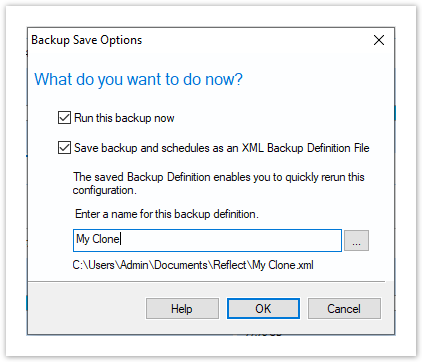It is possible to clone an entire hard drive or specific partitions on a hard drive. This is useful if you are upgrading to a larger hard drive. With Macrium Reflect you can boot the target disk on the same system after cloning. Cloning your hard drive creates a bootable new hard drive with the state of your computer at the time you undertook the clone. You can clone to a hard drive installed in your computer or to a hard drive installed in a USB Drive Caddy.
Important
Deleting and re-configuring existing partitions or configuring new partitions is possible with Macrium Reflect, so you don't need to do this prior to cloning.
Select the disk you wish to clone in the main application window and click Clone this disk...
- In the wizard that opens Click Select a disk to clone to...
Select the hard disk you wish to clone to. In this case, there is only one disk available.
If you do not want to modify the order or size of partitions of the clone, click Next. This is the default behavior.
Alternatively, drag the partitions you want to clone, the red arrow below shows this.Becomes
In this example, there is 650MB of free space after the copied partition. You can modify the size of each partition to fit the new disk if required.
You can delete partitions on the target disk by selecting and clicking 'Delete existing partitions'..To extend the partition to make use of the remaining space on the destination, click Fill Space.
You can open the more detailed Partition Properties dialogue by selecting a partition on the destination then clicking Layout. Using the Partition Properties dialogue you can:
- Set the partition size precisely using the Partition Size entry box.
- Resize the partition automatically by clicking Maximum size or Minimum size. You can set the partition back to the original size by clicking Revert.
- Click OK.
- If required, click Advanced Options to change settings for this clone:Unable to render {include} The included page could not be found.
- Click Next.
The options to Add Schedule, Edit Schedule, or Delete Schedule is displayed.
Click Add Schedule to optionally schedule your clone
Make any required changes and click Next.
For more information see Scheduling backups. - Review the settings and click Finish.
Verify the settings in Backup Save Options and if appropriate, click OK.
Note: Saving a backup definition enables you to run your Clone at any time with a single clickNote: You must save your backup definition if you have created Clone schedules. Your schedules cannot run if this step is missed.If you want to run the Clone at this point, select Run this backup now and click OK.
A Warning box appears, if appropriate click Continue.
Important
The target disk for the clone operation will be overwritten. This is unrecoverable, so please ensure that the target disk contains no valid data.The clone operation now starts.
Incompatible Disk Selected
If you receive the error message 'Incompatible Disk Selected' when cloning then please see this article for more information: .Incompatible Disk Selected
Creating a clone video











